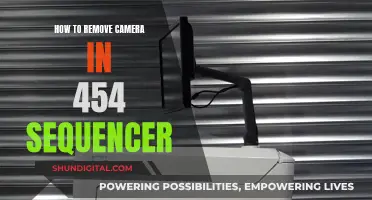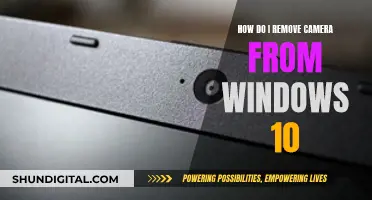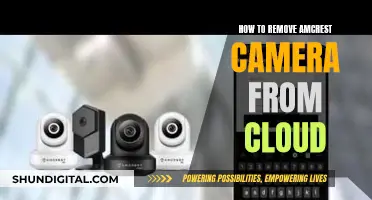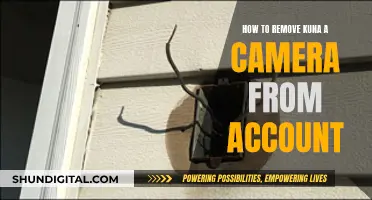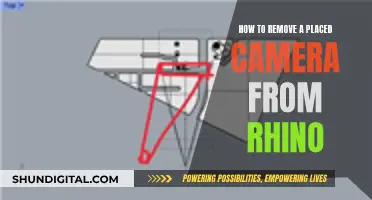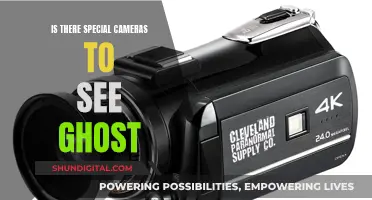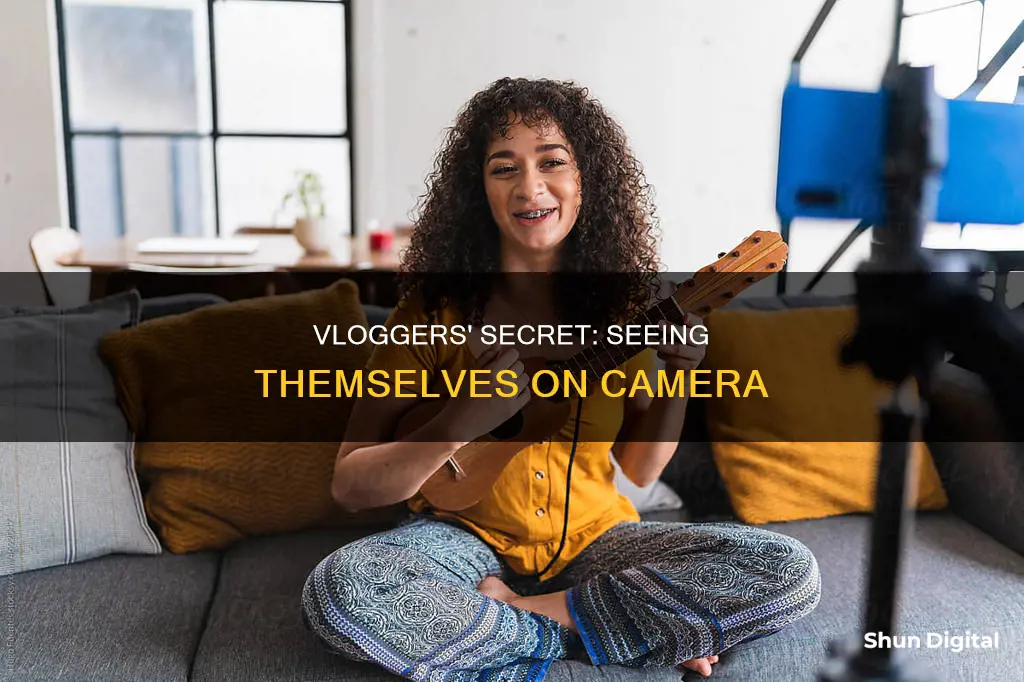
Vlogging has become a popular way to share one's life and interests with the world, and many vloggers strive for a certain level of production value in their videos. A common question that arises for new vloggers is how to see themselves on camera. While there is no one-size-fits-all answer, there are a few techniques and tools that can help vloggers ensure they are framed and focused correctly while filming themselves. In this article, we will explore some of the ways that vloggers can monitor their on-camera appearance and offer tips for setting up their filming equipment to achieve the desired results.
What You'll Learn

Camera angles
- Eye Level Angle: Positioning the camera at eye level with the subject is a classic and straightforward approach. This angle provides a natural and direct perspective, creating a sense of connection with the viewer. It is commonly used in interviews, conversations, or when the vlogger wants to establish a personal connection with the audience.
- High Angle Shot: Shooting from a higher angle can make the subject appear smaller and potentially convey a sense of vulnerability or powerlessness. This angle is often used to showcase the surrounding environment or to give a sense of scale. For vloggers, this angle can be useful when filming in scenic locations or when wanting to emphasise the vastness of their surroundings.
- Low Angle Shot: Conversely, filming from a low angle, below the subject's eye level, can make the subject appear more dominant, powerful, or even heroic. This angle is often used in action or adventure vlogs to emphasise the magnitude of a task or to showcase impressive landscapes.
- Dutch Angle: This is a technique where the camera is tilted to one side, creating a sense of disorientation or unease. It is often used to portray tension, conflict, or a character's internal turmoil. Vloggers might use this angle sparingly to add a creative flair or to emphasise a particular emotion or experience.
- Bird's Eye View: Shooting from directly above the subject provides a unique perspective and can be useful for showcasing specific details or compositions. For vloggers, this angle can be effective for product reviews, unboxing videos, or when wanting to provide a different viewpoint to their audience.
- Worm's Eye View: Conversely, filming from a very low angle, looking up at the subject, can make the subject appear larger than life and emphasise their importance or dominance. This angle is often used in cinematic productions but can also be utilised by vloggers to add variety to their shots or to emphasise a particular moment or object.
Remember, the choice of camera angle depends on the vlogger's creative vision, the type of content they produce, and the emotions or messages they want to convey. Playing around with different angles and experimenting with shot composition can help vloggers develop their unique style and engage their audience in new and interesting ways.
Strategic TV Camera Placement for Soccer: Capturing the Action
You may want to see also

Lighting
Firstly, vloggers should aim to utilise natural light whenever possible. Filming near a window during the day can provide soft and even illumination, creating an appealing and authentic look. However, it's important to avoid direct sunshine, as this can cast dark shadows on the subject's face. Natural light is variable, so vloggers should also be mindful of the time of day and specific locations to achieve consistent results.
For greater control over lighting, vloggers can opt for portable LED lights, which are popular for their ease of setup and consistent, high-quality lighting. These lights can be attached to the camera or placed on stands, providing directional and creative illumination. LED lights also offer adjustable colour settings, allowing vloggers to match ambient light or create specific moods.
Another option is the point-source or chip-on-board (COB) lights, which provide superior power, precision, and creative adaptability. These lights can produce a concentrated beam, useful for achieving dramatic effects or narrow beams of light. Various modifiers can be used with point-source lights to soften, manipulate, or direct the light according to the desired effect.
For vloggers focusing on beauty or headshot videos, LED ring lights are an excellent choice. These lights are designed to evenly illuminate the face, reducing shadows and providing a flattering appearance. Ring lights also create distinct ring-shaped catchlights in the subject's eyes.
When setting up lighting equipment, vloggers should avoid placing the light source directly above, as this can cast distracting shadows. Straight-on lighting is generally preferred, and a window with natural light can help fill out shadows. Harsh side lighting should also be avoided, as it can convey a darker or more solemn mood.
Additionally, vloggers should be mindful of the intensity of the light source. If it's too bright, it can wash out the subject's face. Diffusers can be used to soften the light, and the light source can be moved further away from the subject to adjust the balance.
In conclusion, lighting plays a crucial role in vlogging, and by understanding the different types of lighting equipment and techniques, vloggers can elevate the quality and visual appeal of their videos.
Vizio TV: Microphone, Camera, and Privacy Concerns
You may want to see also

Framing
There are several standard types of framing that vloggers can use to achieve different effects. A medium shot, for example, typically captures the subject from the waist up, and is often used for interviews as it allows the viewer to see the subject's facial expressions and body language. A wide shot, on the other hand, captures the subject in their environment, giving a sense of place. This type of shot is often used to establish the setting at the beginning of a vlog.
Close-up shots are useful for showing detail or creating a sense of intimacy with the viewer, while extreme close-ups can be used to focus attention on a specific object or detail. Vloggers may also use a variety of unconventional framing techniques to create a sense of dynamism or to convey a particular mood or feeling.
In addition to the type of shot, vloggers must also consider the rule of thirds, which involves dividing the image into nine equal sections with two vertical and two horizontal lines. The subject of the image should be positioned at the intersections of these lines, or along the lines themselves, rather than in the centre of the frame. This creates a more interesting and visually appealing composition.
Another important consideration is headroom, which refers to the space between the top of the subject's head and the top of the frame. Vloggers should generally avoid leaving too much headroom, as this can make the image look unbalanced. However, it is also important to ensure that the subject's head is not cut off at the top of the frame, as this can be distracting for the viewer.
Finally, vloggers should be mindful of the background of their shots, ensuring that it is not too cluttered or distracting. A simple background can help to keep the focus on the subject, while a more detailed background can add context or convey additional information.
Chinese Cameras: Watching People, Invading Privacy
You may want to see also

Camera type
The camera type you choose for vlogging depends on the type of vlogs you want to create. For instance, if you're an adventurer, you might want to use a GoPro, whereas a food vlogger might opt for a mirrorless interchangeable lens camera (ILC). Here is a more detailed breakdown of the different types of cameras for vlogging:
Smartphones
Smartphones are a convenient choice for vlogging as they are always on hand and can capture excellent footage. Flagship smartphones, such as the Apple iPhone 15 Pro Max, offer a range of angles and support 4K60 recording. They also provide optical stabilization and advanced editing features, making them a popular choice for many vloggers.
Compact Cameras
Compact cameras are a good option if you want something pocketable and don't want to deal with interchangeable lenses. The Canon PowerShot V10, DJI Osmo Pocket 3, and Sony ZV-1M2 are recommended options in this category. They offer wide-angle lenses, image stabilization, and 4K capture, making them ideal for travelling light.
Interchangeable Lens Cameras (ILC)
If you want the option to change lenses, then an ILC is the way to go. The Nikon Z 30 and Sony ZV-E10 II are great entry-level choices with APS-C sensors and better-than-average mics. For a midrange model with a stabilized sensor, the Fujifilm X-S20 is a good option, although you'll need to factor in the cost of a mic.
Full-Frame Cameras
If you're looking for a camera that can blur backgrounds more easily and has AI-based features, then a full-frame camera like the Sony ZV-E1 is a great choice. It has a range of features designed for content creators, such as a widescreen CineVlog look and an autofocus mode for product reviews.
Action Cameras
Action cameras are perfect for vlogs that involve energetic outdoor activities. The GoPro Hero12 Black is a popular choice due to its high-resolution and highly stabilized video. It also has a forward-facing screen and multiple field-of-view options, making it versatile for different types of shots.
Drones
Drones are excellent for adding cinematic establishing shots, casual walk-and-talks, and action footage to your vlogs. The DJI Mini 4 Pro is a lightweight and portable option that offers high-end features such as obstacle avoidance and an excellent camera.
360-Degree Cameras
If you want to add special effects shots to your vlogs, a 360-degree camera like the Insta360 X4 can capture mind-bending hyperlapse footage and give your viewers a true sense of your surroundings.
In summary, the type of camera you choose for vlogging depends on your specific needs and the type of vlogs you want to create. Smartphones and compact cameras are convenient and easy to use, while ILCs and full-frame cameras offer more flexibility with interchangeable lenses. Action cameras and drones are perfect for outdoor and action shots, and 360-degree cameras can add a unique touch to your footage.
Transform Your Camera into a TV: A Step-by-Step Guide
You may want to see also

Self-perception
- Comfort and Confidence: Vloggers need to feel comfortable in their own skin and confident in their ability to connect with their audience. This involves embracing their unique personalities, interests, and perspectives, and using them to create engaging content. It takes confidence to put oneself out there, and vloggers who are comfortable with self-expression tend to have a more authentic and appealing presence on camera.
- Self-Awareness: Successful vloggers are often highly self-aware. They understand their strengths and weaknesses, and use this knowledge to craft their on-camera persona. They know how to highlight their best qualities and use their quirks to their advantage, creating a relatable and entertaining presence for their viewers.
- Authenticity: Being genuine and authentic is crucial for vloggers. They strive to present themselves truthfully and avoid coming across as fake or disingenuous. This authenticity helps build trust with their audience, fostering a sense of community and engagement. Vloggers who are true to themselves tend to attract a loyal following.
- Adaptability: Vloggers need to be adaptable and open to feedback. They understand that their on-camera persona may evolve over time as they receive comments and suggestions from their viewers. Being receptive to constructive criticism helps them refine their content and delivery, allowing them to better connect with their audience.
- Self-Improvement: Many vloggers see room for self-improvement and are constantly striving to enhance their skills. They may work on improving their communication, storytelling, or presentation abilities. This can involve learning new techniques, experimenting with different styles, or even acquiring technical skills related to video production and editing.
- Audience Connection: Vloggers often develop a strong sense of connection with their audience. They may see themselves as influencers or educators, aiming to inform, inspire, or entertain their viewers. This sense of responsibility and desire to connect positively with their audience can shape their self-perception and motivate them to create meaningful content.
Vlogging requires a unique blend of confidence, self-awareness, and authenticity. Successful vloggers understand the importance of embracing their true selves while also being open to growth and adaptation based on audience feedback. This delicate balance helps them create engaging and relatable content that resonates with their viewers.
Smart TV Webcam: What You Need to Know
You may want to see also
Frequently asked questions
This depends on your budget and needs. You can use a smartphone, compact camera, mirrorless camera, DSLR, or action camera. If you're looking for something more affordable and convenient, a smartphone or compact camera is a good option. If you want more control over your footage and are willing to invest more money, a mirrorless camera or DSLR might be a better choice. For outdoor activities and adventures, an action camera like a GoPro is ideal.
There are several accessories you can use to enhance your vlogs. A gimbal can help stabilise your footage, especially if you're shooting handheld. A tripod is useful for keeping the camera steady and framed correctly, especially when you're appearing in the shot yourself. An external microphone will improve your audio quality, making it easier for viewers to hear you clearly, even in noisy environments.
Some key features to consider when choosing a vlogging camera include a fully articulated screen that flips to the side, continuous autofocus while recording video, face recognition to keep the focus on you, touch-to-focus capability, an external microphone input, optical image stabilisation, good battery life, and 4K resolution video recording.
To set up your camera for vlogging, you should first ensure that it has a fully articulated screen that you can flip to the side so you can see yourself in the frame. If your camera has continuous autofocus and face recognition, enable those features to keep the focus on yourself during the recording. If you're using a tripod, position it at eye level or slightly above for the most flattering angle. If you're holding the camera, make sure your arm is extended and the camera is steady to avoid shaky footage.
Here are some tips to consider: practice speaking to the camera beforehand to get comfortable, dress appropriately for your vlog's topic and setting, be yourself and let your personality shine through, maintain eye contact with the camera, and use hand gestures to emphasise your points and engage your audience. Remember, it's okay to make mistakes—you can always edit out any awkward moments later!


